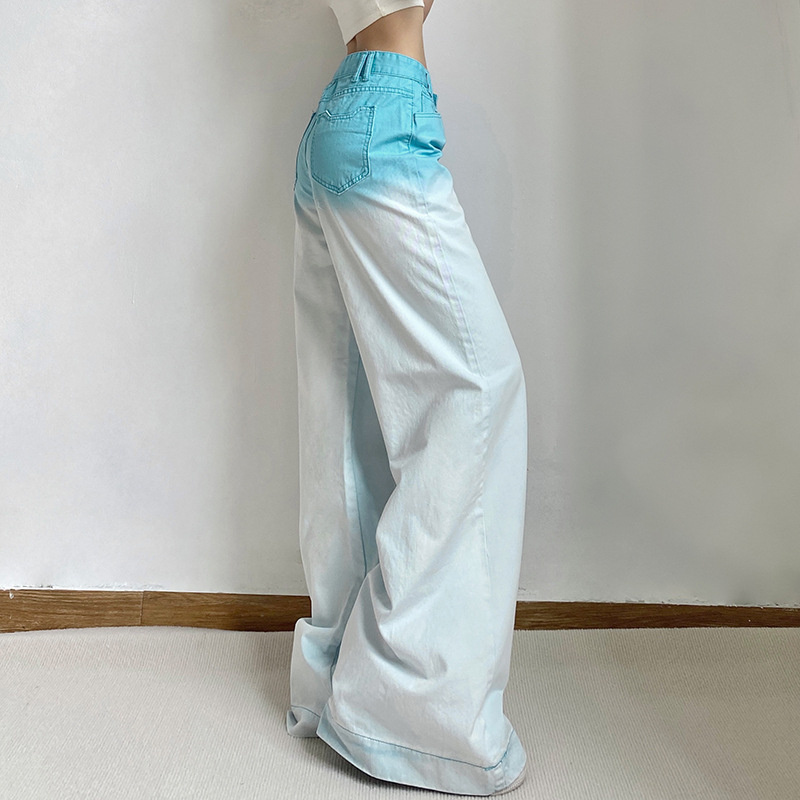
Jeans are a staple in almost every woman's wardrobe, and they can be worn for a variety of occasions. However, with frequent use, it's easy for jeans to start showing signs of wear and tear.
By taking proper care of your women’s jeans, you can help extend their lifespan and keep them looking great for years to come.
Plus, investing time in maintaining your jeans can save you money in the long run, as you won't have to replace them as often. So, let's dive into some tips and tricks for caring for your women's jeans!
What are the Features of Denim

Denim is a sturdy cotton twill fabric that is known for its durability and versatility. It's often used to make jeans, jackets, skirts, and other clothing items. The following are some characteristics of denim that you should be aware of when caring for your women's jeans.
Durability -- There's no doubt that denim is a strong material that resists tearing and ripping. Even so, it is still possible for it to wear down over time if it is used frequently. Denim is made from a strong cotton weave, but it can still be damaged by friction.
As denim is worn, the fibers in the fabric become weaker and can eventually be broken down by constant rubbing against other surfaces.
Color -- The coloration of denim is usually achieved by dyeing it with indigo, which tends to fade over time when worn and washed. A unique and desirable look can be achieved with the use of this technique, but it can also result in uneven coloring if it is not cared for properly.
The fading is caused by the indigo dye molecules breaking apart and being washed away over time. The dye molecules can also be disturbed and moved around during the washing process, creating an uneven look.
Stretch -- To provide more flexibility and comfort, some denim fabrics are infused with spandex or other stretchy fabrics in order to provide that extra stretch and comfort. As a result, these blends can also be more likely to stretch out of shape over a period of time as well.
The Spandex or other stretchy fabrics are usually much more elastic than cotton denim women jeans, so the blended fabric will tend to stretch out more quickly when worn than pure cotton denim. This can lead to the fabric becoming too loose and baggy over time.
How to Care for Your Jeans

The following are more detailed tips for caring for women's jeans so that they last longer. By following these tips, you can help keep your women's jeans looking great and feeling comfortable for years to come.
Remember to always check the care label for specific instructions and to take extra precautions when caring for delicate fabrics or embellishments.
1. In the Washing Process
Action One: Washing Your Jeans with Care
Before washing your jeans, always check the care label for specific instructions. Different types of denim require different care, so it's important to follow the manufacturer's guidelines.
Some jeans are made of delicate fabrics, such as linen and cotton blends, which require cold water and gentle detergent. Other jeans, such as those made from denim, may require more robust cleaning methods, such as machine-washing with hot water.
Knowing the care instructions for your specific jeans is key to extending their life and keeping them looking new.
Action Two: Turn Your Jeans Inside Out
To prevent your jeans for women from fading and to protect any embellishments or details on the outside of the fabric, turn your jeans inside out before washing them.
This helps to ensure that the outer layer of the jeans is not subjected to the direct force of the washing machine's agitator, which would otherwise cause the fabric to break down, resulting in fading and damage to the embellishments or details.

Action Three: Use a Gentle Detergent
If you are washing denim or any other delicate fabric, you should use a gentle detergent that is specifically formulated for denim. It is important to avoid harsh chemicals like bleach and fabric softener, which can damage the fabric and cause it to lose its shape over time.
Harsh chemicals can strip away the color, weaken the fibers, and cause fading and discoloration. Furthermore, fabric softeners leave a waxy residue that can cause the fabric to become stiff and lose its breathability.
Action Four: Wash in the Cold Water
The best way to prevent shrinkage and color fading of your jeans is to wash them in cold water. Water that is too hot can cause the fabric to lose its shape and damage it, so it is best to avoid using heat on the fabric.
Cold water also helps preserve the color of the fabric, as heat can cause the dye to fade over time. By washing in cold water, your jeans will maintain their shape and color for longer.

Action Five: Avoid Using a Dryer
After washing, hang your jeans to air dry or lay them flat on a towel to avoid stretching and wrinkling. Avoid using a high heat setting in the dryer, as this can cause shrinkage and damage to the fabric.
2. In the Washing Process
The dryer should not be set to a high temperature to avoid shrinkage and damage to the fabric, as mentioned earlier. It would be better to air dry your jeans or place them on a flat surface to dry.
You should select a low heat setting on your dryer if you are going to use one, and avoid overdrying your jeans. In the event that the fabric is over-dried, it may become stiff and brittle, resulting in the garment being less comfortable to wear as a result.
In addition, you should avoid wringing out your jeans or twisting them when removing excess water, as this can cause damage to the fabric and reduce the shape of the jeans, particularly for skinny jeans for women.

3. In the Storing Process
If you are storing your jeans for an extended period of time, it is a good idea to fold them neatly and not hang them for too long. The fabric can lose its elasticity after hanging for some time and it will stretch out of shape.
If you want to prevent color fading in your jeans and damage to the fabric, be sure to store them in a dry, cool place away from direct sunlight. Make sure that you don't store your jeans in damp or humid environments, as this can lead to mold and mildew growing on them.
The best way to keep your jeans organized and protected is to use a storage container or vacuum-sealed bag if you have a limited amount of space.
4. In the Daily Wears
It is recommended that you alternate between several pairs of jeans so as to limit the amount of wear and tear and avoid wearing the same pair of jeans on a daily basis.
If you are planning on doing activities that may cause excessive friction, such as cycling or hiking, be sure to avoid wearing your jeans during those activities. The fabric may be damaged in this way, and its lifespan may be reduced as a result.
You should be aware of the fit of your jeans, as too tight or too loose jeans can put excessive strain on the fabric and may lead to premature wear and tear as a result.
Additional Troubleshooting Tips for Common Issues

By learning these troubleshooting techniques, you can extend the life of your women's jeans and avoid having to replace them prematurely.
You should always approach repairs and alterations with caution, and consider seeking professional help if you're unsure how to proceed
Q1: Removing Stains and Spots from Denim
For small stains, spot cleaning is often effective. Use a soft-bristled brush and a mild detergent to gently scrub the affected area, then rinse with cold water and air dry.
For tougher stains or deep cleaning, consider taking your jeans to a professional cleaner who specializes in denim care.
Some stains, such as oil or grease, can be removed with a mixture of baking soda and dish soap. Apply the mixture to the affected area, let it sit for 30 minutes, then rinse with cold water and air dry.
If you are dealing with colored jeans for women, this method should be handled carefully with the utmost care. This is because the mixture can lighten the fabric and cause discoloration if left on the jeans for too long. It's important to thoroughly rinse the mixture off and air dry to prevent any color fading.
Q2: Dearling with Fading
If your jeans have already faded, try soaking them in a mixture of cold water and vinegar for 30 minutes before washing. This can help restore the color and remove any remaining detergent residue.

Q3: Handling Fraying
To prevent fraying along the hemline, consider getting your jeans hemmed by a professional or using fabric glue to create a clean hem.
If your jeans have already started to fray, you can trim off any loose threads and secure the hem with fabric glue or by sewing a new hem in place.
Q4: Removing Wrinkles
To remove wrinkles from your jeans, use a clothes steamer or iron on a low heat setting. Be sure to iron on the wrong side of the fabric to avoid damaging the denim.
Q5: Fixing a Broken Zipper
If your zipper is stuck or broken, try using a pair of pliers to gently pull the slider back into place. If this doesn't work, you may need to replace the zipper entirely.
To replace a zipper, use a seam ripper to remove the old zipper, then sew the new zipper in place using a sewing machine or by hand.
Wrapping Up

By understanding the basics of denim, washing and drying your jeans properly, and troubleshooting common issues, you can keep your jeans in great condition and avoid costly replacements.
Remember to always follow the care label and manufacturer's instructions, use gentle detergents, avoid bleach and fabric softeners, and wash your jeans inside out in cold water to prevent fading and shrinkage.
Also, be sure to store your jeans properly, avoid high heat and hot water, and use gentle drying cycles or air drying to prevent stretching and damage.
When you encounter common issues such as stains, broken zippers, or other issues, don't panic! There are simple solutions such as spot treatments, zipper replacements, and hemming services that can restore your jeans to their former glory.
Ultimately, taking care of your women's jeans is an investment in your wardrobe and your wallet. By following these tips and techniques, you can enjoy your best jeans for women for years to come and feel confident and comfortable in your stylish denim.








